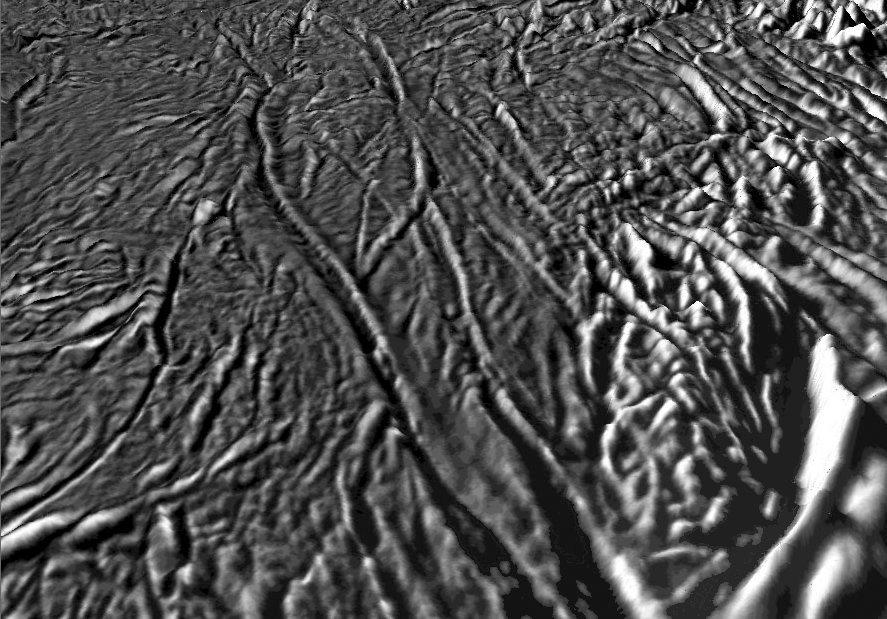Creation Corner
Enceladus confounds experts

Enceladus, ninth moon of Saturn, confounded planetary scientists when Voyager 2 reconnoitered it in 1981. Every rocket-probe reconnaissance of Enceladus confounds them more. If this and all other objects that large or larger in our solar system are billions of years old, why does Enceladus look and act so young? Conventional creation scientists and advocates assume it is as young as the earth – 6,019 years by the Ussher reckoning. In fact Enceladus is even younger – 5,300 years young, give or take a hundred years.
Enceladus throughout history
William Herschel first discovered Enceladus on August 28, 1789. His son Sir John Herschel named this moon after a giant on the Titan-side of the Titan-Olympian War. According to classical myth, the Olympian Athena killed Enceladus in action and buried him in a heap of dirt where he fell. Today he lies beneath Mount Etna in Sicily. When he breathes, Mount Etna erupts.
Sir John might have named Enceladus better than he thought. In 2005, the Cassini orbiter first reconnoitered Enceladus. J. R. Spencer and his team reported on that recon, in the journal Science. They realized something no one suspected: Enceladus has volcanic activity. It spews out plumes of water, with dissolved and suspended particles inside, from its south pole. Enceladus thus joined Earth and Io as the three solar system bodies having volcanoes of any kind.
So for ten years, astronomers have known Enceladus has a lot of heat inside it. But how hot does it get? Spencer and company knew temperatures has to reach 145 kelvins. That’s about 128 degrees Celsius below “freezing,” or more than 198 degrees Fahrenheit below zero. (At zero degrees Fahrenheit, water holding salt in standard saturated solution will freeze.)
But more recently, Hsu and company suggested, in Nature, that Enceladus must get a lot hotter: 363 kelvins, or 90 degrees Celsius (ten degrees below “boiling”), or 194 degrees Fahrenheit – hot enough to overcook most meats.
Can Hsu and team have guessed correctly? If so, that compounds the problem astronomers have always had with Enceladus: it’s too hot to be that old! Why did Mimas, eighth moon out, freeze solid while Enceladus did not? And what could possibly heat any part of Enceladus hot enough to cook a roast lamb? (And likely burn it, too!)
Observations to explain
Enceladus must have a liquid ocean under the ice that covers it. It has 101 jets, or geysers, on its south pole. In 2008, Hansen and her team reported those geysers put out even more water ice when Enceladus is near apokrone (far away from Saturn) than near perikrone. They expected the geysers to put out less, because Saturn’s tides would be weaker. This leads them to conclude: Enceladus has a liquid ocean beneath its south pole, like Lake Vostok under the Antarctic ice. Water from this ocean escapes through the ice, at supersonic speed.
Enceladus throws out more than water ice. The south polar jets hold silica – sand! Where did that come from? Hsu and company believe hydrothermal reactions are making these particles of sand (and salt). (They speak of “liquid water that is, or has been, in contact with rock.”) Officials at the Jet Propulsion Laboratory, which controls many rocket-probe missions, talk hopefully of finding life on Enceladus. Where they find (or think they find) hydrothermal activity, they hope to find life. (Some scientists speculate the hydrothermal vents along the Mid-Oceanic Ridge system gave us the “biological ylem” out of which the first living things put themselves together in the wild.)
[ezadsense midpost]
Alexis Bouquet and her team reported another finding three months ago, that relates to finding life. In Geophysical Research Letters, they described methane in some of those ice crystals. Ice, under the right conditions, forms a lattice-like crystal. Sometimes this lattice can trap a volatile compound, like methane, inside it. Astronomers have known about such clathrate particles (from the Latin word for a lattice) since Cassini first sniffed them out by passing through the geysers. Bouquet and her team now think they can explain what made them. They say clathrate particles can easily form in the subglacial ocean of Enceladus, as they might form in Lake Vostok or a similar lake under ice on Earth. But they have another problem: where does the methane come from? Like Hsu and company, they talk of hydrothermal reactions adding methane to the ocean.
To sum up, anyone trying to explain Enceladus – how old it is, and where it came from – must account for these facts: Enceladus has a vast coating of ice with liquid water beneath it. That water holds suspended sand and dissolved salt and methane. Enceladus gets hot enough to spew some of that suspension into space. (The particles float in orbit around Saturn as the E ring, though some drop as far down as the A ring.) And this spewing has gone on since Enceladus first formed, or shortly after that.
Enceladus formed from Earth material
Brian Thomas, writing at the Institute for Creation Research, argues Enceladus cannot have lasted for billions of years. Enceladus should have frozen solid. Besides, what limitless supply of water could Enceladus have had, to keep spewing out particles of water, some laced with sand, salt, or methane, for billions of years? His answer: God created Enceladus when He created Saturn, and all the other planets, thousands of years ago, not billions.
A recent origin of Enceladus does explain why we can still watch these processes today. But no man of earth saw Enceladus before 1789, when William Herschel first saw it. How, then, could Enceladus serve as a marker for seasons and years, like other “Day Four” objects (the sun, moon, and stars)?
Walter T. Brown, at the Center for Scientific Creation, reminds anyone who will listen: do not multiply miracles without Scriptural testimony or other clearly obvious reason. He does not invoke direct creation to explain Enceladus. By his theory, Enceladus is even younger than the earth.
The Hydroplate Theory of the Global Flood holds that Earth originally had an ocean not merely subglacial but sub-crustal, or even within the mantle. These waters, as much as fifty miles underground and two miles deep, broke containment 5300 years ago (give or take a hundred). This breakout caused more than a Global Flood. As much as four percent of Earth’s mass escaped Earth as water, rock, mud, and dissolved volatiles and minerals. With it went at least some living things, including microbes and probably including shrubs and trees.
Some of this material coalesced to form Enceladus. (Enceladus weighs less than one five-thousandth of what the earth weighs.) The sun then heated Enceladus, always on whatever side faced it. A day on Enceladus lasts about 32 Earth hours, enough time for heat to build up on the daylight side. This heating would push material below the surface toward the “night” side. (In fact the vector would point slightly ahead of “midnight,” thus giving the body more prograde angular momentum that would keep it in a “higher” orbit from the sun.) This continual movement, acting like an engine, pushed Enceladus on a spiral course away from the sun, beyond the main asteroid belt. Eventually Enceladus drifted near Saturn and fell into orbit around it.
Tidal pumping keeps Enceladus hot enough to squirt out more of the water, and everything suspended or dissolved in it, even today. The methane could come from microbes breaking down any vegetable matter inside the liquid lake beneath the south pole. The salt and sand likely came from the subcrustal waters. These waters were supercritically hot (more than 700 kelvins) and held large amounts of dissolved minerals.
Why would anyone think of hydrothermal reactions? Because they have seen similar materials in Earth’s hydrothermal vents. But those vents point the Global Flood also. They are the Black Smokers and White Smokers along the Mid-Oceanic Ridge. Those smokers hold the last of the subcrustal waters, still escaping from the seam where the bulk of those waters broke out, fifty-three hundred years ago.
Reprinted from examiner.com
[ezadsense leadout]
Terry A. Hurlbut has been a student of politics, philosophy, and science for more than 35 years. He is a graduate of Yale College and has served as a physician-level laboratory administrator in a 250-bed community hospital. He also is a serious student of the Bible, is conversant in its two primary original languages, and has followed the creation-science movement closely since 1993.
-

 Civilization2 days ago
Civilization2 days agoDC Pipe Bomb Arrest Raises Questions About Christopher’s Wray’s FBI
-

 Guest Columns4 days ago
Guest Columns4 days agoCongressional Leaders See Far Higher Stock Returns Than Peers
-

 Civilization3 days ago
Civilization3 days agoThe Legal Logic Behind U.S. Operations Against Narco-Terrorist Networks
-

 Civilization4 days ago
Civilization4 days agoHow Trump Changed America
-

 Executive3 days ago
Executive3 days agoNewsom’s ‘National Model’ for Homeless Wracked by Fraud
-

 Executive2 days ago
Executive2 days agoWhen You’re in a Hole, Stop Digging
-

 Education2 days ago
Education2 days agoWaste of the Day: Taxpayers Subsidize Football Coach Severance
-

 Civilization1 day ago
Civilization1 day agoPence Calls on Trump To Fire RFK Jr Over Abortion Drug



















[…] from examiner.com and from Conservative News and […]
“Enceladus thus joined Earth and Io as the three solar system bodies having volcanoes of any kind.”
Uh, Venus?
Have you a reference that says Venus is volcanically active? It’s stiflingly hot, all right. But volcanic? Never heard that.
“And what could possibly heat any part of Enceladus hot enough to cook a roast lamb?”
Tides. That’s basic stuff.
I did not see any comprehensive model to show how hot Enceladus could get with tidal pumping alone. Hot enough to produce those geysers, maybe. But we’re now talking hot enough to produce something like the Black Smokers of the Mid-Oceanic Ridge.
ESA and NASA orbiters have both detected sulphur dioxide plumes. The ESA orbiter has thermal images of probable lava flows on Maat Mons, a giant shield volcano.
How long ago did they develop this finding? By the way, for the uninitiated, you’re now talking about the planet Venus, a planet with a retrograde day.
“How long ago did they develop this finding?”
2013, I believe.
“the planet Venus, a planet with a retrograde day.”
Yes. Interesting, isn’t it?